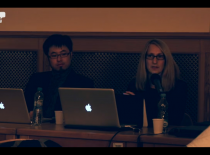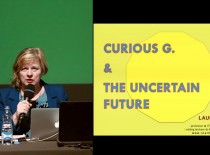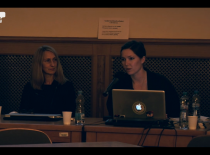Prague - December 7, 2012
Georg Tremmel presents his paper within the panel Blueprints for the Unknown at International conference Mutamorphosis in Prague, Czech Republic.
The structure of DNA was famously discovered by James Watson & Francis Crick in 1953, but it was not until 1961 that the “Genetic Code” was broken and the way information is encoded in the DNA was revealed. Around the same time, Lisp – one of the first higher-level computer programming languages – was developed. In Lisp, code (programs) and data are interchangeable. Code can be interpreted as data; Data can be interpreted as Code. This homoiconicity (“same representation”) of code and data enables metaprogramming, which allows a program to be its own compiler.
Since these defining moments, biological science and computer science (informatics) have started to converge. Fields and research areas such as Genetic Algorithms, Genetic Programming, Computational Biology, Biological Computation can all be seen as a combination of biology and informatics, or as Bio-informatics. Experiments in “real life” (in vivo) became experiments in glass (in vitro), which turned into simulations of experiments in computers (in silico).
In this paper we present the logical and inevitable culmination of unifying the biological and computer science: DNA, a novel programming language consisting only of the four letters A, T, C and G. Programs written in DNA will not only resemble genetic information, they will be genetic information. The same program, that executes on a computer can be expressed in an biological life-form (bacteria). The same gene, that is expressed in bacteria can be executed on a computer.
It did not escape out attention, that this unification of codes also gives rise to the convergence of the symbolic and the real. It also gives rise to a range of new possibilities which will be explored further in the paper:
- Trans-species computation
- Cross-species compiling
- Genes as programs
- Programs as genes
- Computer virus as a biological virus as a computer virus
- DNA database mining for hidden programs/genes
- etc
In 1958 George Beadle was awarded the nobel prize in Physiology or Medicine. Before the ceremony his peer Max Delbrück engaged Beadle in an exchange of messages about the nature of the genetic code, in with Delbrück send a 229-letters message to Beadle, which when decoded read “BREAK-THIS-CODE-OR-GIVE-BACK-NOBEL-PRIZE-LEDERBERGGO- HOME-MAX-MARKO-STERLING.” Beadle replied with his own message, showing his conviction that the genetic code does not contains spaces: “GWBTOMDIMSUREITSAFINEMESSAGEIFICOULDDOTHEFINALSTEP”. Determined to have to last say, Delbrück constructed a model of colored toothpick, shipped it to Stockholm, where it was presented to Beadle right after his official Nobel Prize lecture. Beadle decoded the message encode in the four colours of the toothpicks on the spot: “I am the riddle of life. Know me and you will know yourself.”
This Beadle-Delbrück exchange is important to history for both art and sciences, because it showed the concept of incorporating extra-biological information in the key elements of life themselves. It also illustrates the idea that life can be seen as information, and vice versa, information can be seen as life.
This project can probably not provide answers to biological hard questions, it provide a short-circuit between biology and informatics, between the symbolic and the real. We hope that the sparks from this short circuit can stimulate thoughts and discussion about the meaning of the convergence of biology and informatics.
- Tags:




 Copyright © 2025 ARTISTTALK. All Rights Reserved.
Copyright © 2025 ARTISTTALK. All Rights Reserved.
0 Comments
You can be the first one to leave a comment.